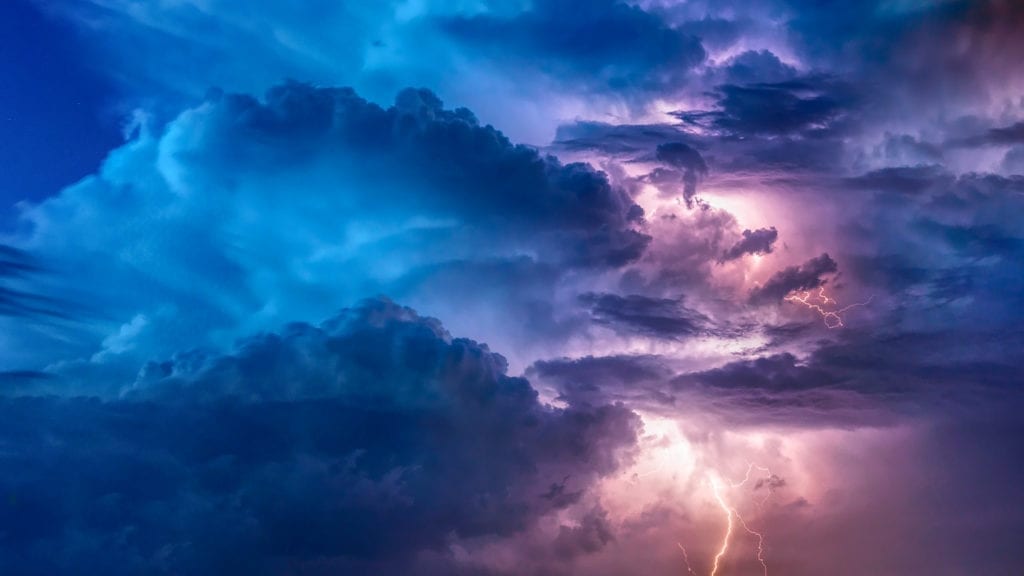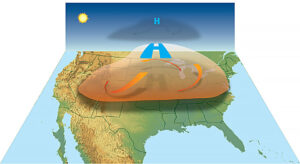Spring approaches here in Oklahoma and that means thunderstorms and severe weather, which generate lightning, one of nature’s most beautiful yet deadly phenomenon. What is lightning? How is lightning produced? What causes thunder? How can you be safe during lightning?
What is lightning?
Lightning is a discharge of electricity in the atmosphere between clouds, the air, or the ground. Air acts an insulator between positive and negative charges in the cloud and between the cloud and ground. When the opposite charges reach a certain level, or difference of potential, called voltage, the insulating capacity of the air breaks down and there is a rapid discharge of electricity. This discharge temporarily equalizes the charged regions in the atmosphere until opposite charges build up again.
Lightning can occur between charges in a thunderstorm cloud or between opposite charges in the cloud and the ground. Lightning between charges in a cloud is called intra-cloud lightning. Lightning that occurs between charges in the cloud and the ground is called cloud-ground lightning.
When cloud-ground lightning is produced, a channel, known as a stepped leader is formed. This is invisible to the naked eye and allows electrons to move from the cloud to the ground.
The stepped leader derives its name from the fact that it travels in 50 to 100-meter sections, with a slight pause in between, to the ground. As it nears the ground, a positively charged streamer discharges from the ground to connect with the stepped leader. Streamers are most often initiated from tall objects to the ground.
Once connected, electrons from the cloud can flow to the ground and positive charges can flow from the ground to the cloud. It is this flow of positive charge that is visible as a lightning strike.
This process can be repeated 3-4 times in rapid succession. All this occurs in approximately 200 milliseconds or two-tenths of a second.
How is lightning produced?
How lightning is produced is a complicated process. The conditions that are needed to produce lighting are known and understood, but there is a debate about how a cloud builds up electrical charges. There are two schools of thought that attempt to explain the creation of charges in the clouds.
The precipitation theory postulates that different sized raindrops and hail obtain their positive and negative charges as they collide with the heavier particles carrying the negative charges to the lower part of the cloud.
The convection theory postulates that updrafts transport positive charges found near the ground, while downdrafts carry negative charges downward.
What causes thunder?
In a few hundred milliseconds, lightning heats the air around it to 30,000 degrees Celsius. That is five times hotter than the surface of the sun.
The heated air expands rapidly, creating a shockwave as the surrounding air is compressed. The air contracts rapidly as it is cooled. This creates the initials “crack” sound, followed by rumbles as the column of air continues to vibrate.
We see the lightning before we hear the thunder. That is because light travels much faster than sound waves. We can estimate the distance by counting how many seconds it takes until we hear thunder. It takes approximately five seconds for the sound to travel one mile. If the thunder occurs almost instantly, you are dangerously close to the lightning.
How can You be Safe during Lightning?
A thunderstorm contains more energy than an atomic bomb. A single lightning strike contains a core of energy about two inches in diameter that contains up to a billion volts and 200,000 amperes of electrical current. Lighting typically kills more people than tornadoes. Here are some safety tips:
No place outside is safe near a thunderstorm.
Plan your outdoor activities so that you can get to a safe place in case a thunderstorm develops.
Remember: When thunder roars, go indoors! If you can hear thunder, the storm is near enough to you to pose an immediate threat; after the thunder ends, wait 30 minutes before resuming outdoor activities
If thunderclouds are anywhere near, you should not be outside. Lightning can travel long distances. It doesn’t have to be raining overhead for lightning to strike. Don’t wait until the “last minute” to seek shelter. You don’t want to be a victim of a “bolt from the blue.”
If you are outside, go inside an enclosed building.
Once inside a closed building, stay away from windows, showers, sinks, bathtubs, and electronic equipment such as TVs, radios, corded telephones, and computers.
If you are caught outside and can’t get to a safe place, there are things you should avoid so that you don’t increase the chance of being struck. Never take shelter under a tree and stay away from other tall things like utility and flag poles, but avoid open areas and high ground. Stay away from metal bleachers and fences. Never lie on the ground as that increase the chances of being struck by dangerous ground current.
You are generally safe in an enclosed metal vehicle, not because of the rubber tires, but because the electrical current flows around the outside edge of the metal. You should roll up your windows and not be in contact with any metal in the vehicle.
For more information on lightning safety, go to https://www.weather.gov/safety/lightning-safety











